Rings of Saturn theme by Dennis “F-Rott” Ferrand
Download: RingsofSaturn.p3t
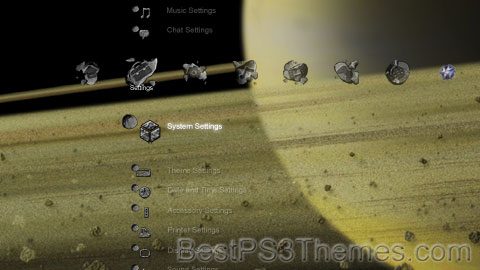
(3 backgrounds)

The rings of Saturn are the most extensive and complex ring system of any planet in the Solar System. They consist of countless small particles, ranging in size from micrometers to meters,[1] that orbit around Saturn. The ring particles are made almost entirely of water ice, with a trace component of rocky material. There is still no consensus as to their mechanism of formation. Although theoretical models indicated that the rings were likely to have formed early in the Solar System's history,[2] newer data from Cassini suggested they formed relatively late.[3]
Although reflection from the rings increases Saturn's brightness, they are not visible from Earth with unaided vision. In 1610, the year after Galileo Galilei turned a telescope to the sky, he became the first person to observe Saturn's rings, though he could not see them well enough to discern their true nature. In 1655, Christiaan Huygens was the first person to describe them as a disk surrounding Saturn.[4] The concept that Saturn's rings are made up of a series of tiny ringlets can be traced to Pierre-Simon Laplace,[4] although true gaps are few – it is more correct to think of the rings as an annular disk with concentric local maxima and minima in density and brightness.[2] On the scale of the clumps within the rings there is much empty space.
The rings have numerous gaps where particle density drops sharply: two opened by known moons embedded within them, and many others at locations of known destabilizing orbital resonances with the moons of Saturn. Other gaps remain unexplained. Stabilizing resonances, on the other hand, are responsible for the longevity of several rings, such as the Titan Ringlet and the G Ring.
Well beyond the main rings is the Phoebe ring, which is presumed to originate from Phoebe and thus share its retrograde orbital motion. It is aligned with the plane of Saturn's orbit. Saturn has an axial tilt of 27 degrees, so this ring is tilted at an angle of 27 degrees to the more visible rings orbiting above Saturn's equator.

In September 2023, astronomers reported studies suggesting that the rings of Saturn may have resulted from the collision of two moons "a few hundred million years ago".[5][6]
History[edit]
Early observations[edit]
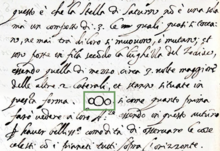
Galileo Galilei was the first to observe the rings of Saturn in 1610 using his telescope, but was unable to identify them as such. He wrote to the Duke of Tuscany that "The planet Saturn is not alone, but is composed of three, which almost touch one another and never move nor change with respect to one another. They are arranged in a line parallel to the zodiac, and the middle one (Saturn itself) is about three times the size of the lateral ones."[7] He also described the rings as Saturn's "ears". In 1612 the Earth passed through the plane of the rings and they became invisible. Mystified, Galileo remarked "I do not know what to say in a case so surprising, so unlooked for and so novel."[4] He mused, "Has Saturn swallowed his children?" — referring to the myth of the Titan Saturn devouring his offspring to forestall the prophecy of them overthrowing him.[7][8] He was further confused when the rings again became visible in 1613.[4]
Early astronomers used anagrams as a form of commitment scheme to lay claim to new discoveries before their results were ready for publication. Galileo used the anagram "smaismrmilmepoetaleumibunenugttauiras" for Altissimum planetam tergeminum observavi ("I have observed the most distant planet to have a triple form") for discovering the rings of Saturn.[9][10][11]
In 1657 Christopher Wren became Professor of Astronomy at Gresham College, London. He had been making observations of the planet Saturn from around 1652 with the aim of explaining its appearance. His hypothesis was written up in De corpore saturni, in which he came close to suggesting the planet had a ring. However, Wren was unsure whether the ring was independent of the planet, or physically attached to it. Before Wren's hypothesis was published Christiaan Huygens presented his hypothesis of the rings of Saturn. Immediately Wren recognised this as a better hypothesis than his own and De corpore saturni was never published. Robert Hooke was another early observer of the rings of Saturn, and noted the casting of shadows on the rings.[12]
Huygens' ring hypothesis and later developments[edit]

Huygens began grinding lenses with his father Constantijn in 1655 and was able to observe Saturn with greater detail using a 43× power refracting telescope that he designed himself. He was the first to suggest that Saturn was surrounded by a ring detached from the planet, and famously published the anagram: "aaaaaaacccccdeeeeeghiiiiiiillllmmnnnnnnnnnooooppqrrstttttuuuuu".[13] Three years later, he revealed it to mean Annulo cingitur, tenui, plano, nusquam coherente, ad eclipticam inclinato ("[Saturn] is surrounded by a thin, flat, ring, nowhere touching [the body of the planet], inclined to the ecliptic").[14][4][15] He published his ring hypothesis in Systema Saturnium (1659) which also included his discovery of Saturn's moon, Titan, as well as the first clear outline of the dimensions of the Solar System.[16]
In 1675, Giovanni Domenico Cassini determined that Saturn's ring was composed of multiple smaller rings with gaps between them;[17] the largest of these gaps was later named the Cassini Division. This division is a 4,800-kilometre-wide (3,000 mi) region between the A ring and B Ring.[18]
In 1787, Pierre-Simon Laplace proved that a uniform solid ring would be unstable and suggested that the rings were composed of a large number of solid ringlets.[19][4][20]
In 1859, James Clerk Maxwell demonstrated that a nonuniform solid ring, solid ringlets or a continuous fluid ring would also not be stable, indicating that the ring must be composed of numerous small particles, all independently orbiting Saturn.[21][20] Later, Sofia Kovalevskaya also found that Saturn's rings cannot be liquid ring-shaped bodies.[22][23] Spectroscopic studies of the rings which were carried out independently in 1895 by James Keeler of the Allegheny Observatory and by Aristarkh Belopolsky of the Pulkovo Observatory showed that Maxwell's analysis was correct.[24][25]
Four robotic spacecraft have observed Saturn's rings from the vicinity of the planet. Pioneer 11's closest approach to Saturn occurred in September 1979 at a distance of 20,900 km (13,000 mi).[26] Pioneer 11 was responsible for the discovery of the F ring.[26] Voyager 1's closest approach occurred in November 1980 at a distance of 64,200 km (39,900 mi).[27] A failed photopolarimeter prevented Voyager 1 from observing Saturn's rings at the planned resolution; nevertheless, images from the spacecraft provided unprecedented detail of the ring system and revealed the existence of the G ring.[28] Voyager 2's closest approach occurred in August 1981 at a distance of 41,000 km (25,000 mi).[27] Voyager 2's working photopolarimeter allowed it to observe the ring system at higher resolution than Voyager 1, and to thereby discover many previously unseen ringlets.[29] Cassini spacecraft entered into orbit around Saturn in July 2004.[30] Cassini's images of the rings are the most detailed to-date, and are responsible for the discovery of yet more ringlets.[31]
The rings are named alphabetically in the order they were discovered[32] (A and B in 1675 by Giovanni Domenico Cassini, C in 1850 by William Cranch Bond and his son George Phillips Bond, D in 1933 by Nikolai P. Barabachov and B. Semejkin, E in 1967 by Walter A. Feibelman, F in 1979 by Pioneer 11, and G in 1980 by Voyager 1). The main rings are, working outward from the planet, C, B and A, with the Cassini Division, the largest gap, separating Rings B and A. Several fainter rings were discovered more recently. The D Ring is exceedingly faint and closest to the planet. The narrow F Ring is just outside the A Ring. Beyond that are two far fainter rings named G and E. The rings show a tremendous amount of structure on all scales, some related to perturbations by Saturn's moons, but much unexplained.[32]
In September 2023, astronomers reported studies suggesting that the rings of Saturn may have resulted from the collision of two moons "a few hundred million years ago".[5][6]
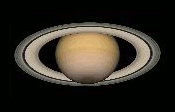
Saturn's axial inclination[edit]
Saturn's axial tilt is 26.7°, meaning that widely varying views of the rings, of which the visible ones occupy its equatorial plane, are obtained from Earth at different times.[33] Earth makes passes through the ring plane every 13 to 15 years, about every half Saturn year, and there are about equal chances of either a single or three crossings occurring in each such occasion. The most recent ring plane crossings were on 22 May 1995, 10 August 1995, 11 February 1996 and 4 September 2009; upcoming events will occur on 23 March 2025, 15 October 2038, 1 April 2039 and 9 July 2039. Favorable ring plane crossing viewing opportunities (with Saturn not close to the Sun) only come during triple crossings.[34][35][36]
Saturn's equinoxes, when the Sun passes through the ring plane, are not evenly spaced. The sun passes south to north through the ring plane when Saturn's heliocentric longitude is 173.6 degrees (e.g. 11 August 2009), about the time Saturn crosses from Leo to Virgo. 15.7 years later Saturn's longitude reaches 353.6 degrees and the sun passes to the south side of the ring plane. On each orbit the Sun is north of the ring plane for 15.7 Earth years, then south of the plane for 13.7 years.[a] Dates for north-to-south crossings include 19 November 1995 and 6 May 2025, with south-to-north crossings on 11 August 2009 and 23 January 2039.[38] During the period around an equinox the illumination of most of the rings is greatly reduced, making possible unique observations highlighting features that depart from the ring plane.[39]
Physical characteristics[edit]
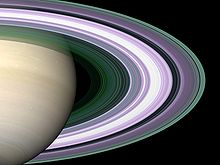
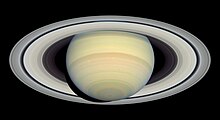
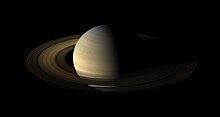
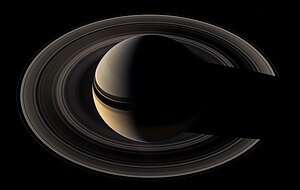
The dense main rings extend from 7,000 km (4,300 mi) to 80,000 km (50,000 mi) away from Saturn's equator, whose radius is 60,300 km (37,500 mi) (see Major subdivisions). With an estimated local thickness of as little as 10 metres (32' 10")[40] and as much as 1 km (1093 yards),[41] they are composed of 99.9% pure water ice with a smattering of impurities that may include tholins or silicates.[42] The main rings are primarily composed of particles smaller than 10 m.[43]
Cassini directly measured the mass of the ring system via their gravitational effect during its final set of orbits that passed between the rings and the cloud tops, yielding a value of 1.54 (± 0.49) × 1019 kg, or 0.41 ± 0.13 Mimas masses.[3] This is around two-thirds the mass of the Earth's entire Antarctic ice sheet, spread across a surface area 80 times larger than that of Earth.[44][45] The estimate is close to the value of 0.40 Mimas masses derived from Cassini observations of density waves in the A, B and C rings.[3] It is a small fraction of the total mass of Saturn (about 0.25 ppb). Earlier Voyager observations of density waves in the A and B rings and an optical depth profile had yielded a mass of about 0.75 Mimas masses,[46] with later observations and computer modeling suggesting that was an underestimate.[47]
Although the largest gaps in the rings, such as the Cassini Division and Encke Gap, can be seen from Earth, the Voyager spacecraft discovered that the rings have an intricate structure of thousands of thin gaps and ringlets. This structure is thought to arise, in several different ways, from the gravitational pull of Saturn's many moons. Some gaps are cleared out by the passage of tiny moonlets such as Pan,[48] many more of which may yet be discovered, and some ringlets seem to be maintained by the gravitational effects of small shepherd satellites (similar to Prometheus and Pandora's maintenance of the F ring). Other gaps arise from resonances between the orbital period of particles in the gap and that of a more massive moon further out; Mimas maintains the Cassini Division in this manner.[49] Still more structure in the rings consists of spiral waves raised by the inner moons' periodic gravitational perturbations at less disruptive resonances.[citation needed] Data from the Cassini space probe indicate that the rings of Saturn possess their own atmosphere, independent of that of the planet itself. The atmosphere is composed of molecular oxygen gas (O2) produced when ultraviolet light from the Sun interacts with water ice in the rings. Chemical reactions between water molecule fragments and further ultraviolet stimulation create and eject, among other things, O2. According to models of this atmosphere, H2 is also present. The O2 and H2 atmospheres are so sparse that if the entire atmosphere were somehow condensed onto the rings, it would be about one atom thick.[50] The rings also have a similarly sparse OH (hydroxide) atmosphere. Like the O2, this atmosphere is produced by the disintegration of water molecules, though in this case the disintegration is done by energetic ions that bombard water molecules ejected by Saturn's moon Enceladus. This atmosphere, despite being extremely sparse, was detected from Earth by the Hubble Space Telescope.[51] Saturn shows complex patterns in its brightness.[52] Most of the variability is due to the changing aspect of the rings,[53][54] and this goes through two cycles every orbit. However, superimposed on this is variability due to the eccentricity of the planet's orbit that causes the planet to display brighter oppositions in the northern hemisphere than it does in the southern.[55]
In 1980, Voyager 1 made a fly-by of Saturn that showed the F ring to be composed of three narrow rings that appeared to be braided in a complex structure; it is now known that the outer two rings consist of knobs, kinks and lumps that give the illusion of braiding, with the less bright third ring lying inside them.[citation needed]
New images of the rings taken around the 11 August 2009 equinox of Saturn by NASA's Cassini spacecraft have shown that the rings extend significantly out of the nominal ring plane in a few places. This displacement reaches as much as 4 km (2.5 mi) at the border of the Keeler Gap, due to the out-of-plane orbit of Daphnis, the moon that creates the gap.[56]
Formation and evolution of main rings[edit]
Estimates of the age of Saturn's rings vary widely, depending on the approach used. They have been considered to possibly be very old, dating to the formation of Saturn itself. However, data from Cassini suggest they are much younger, having most likely formed within the last 100 million years, and may thus be between 10 million and 100 million years old.[3][57] This recent origin scenario is based on a new, low mass estimate, modeling of the rings' dynamical evolution, and measurements of the flux of interplanetary dust, which feed into an estimate of the rate of ring darkening over time.[3] Since the rings are continually losing material, they would have been more massive in the past than at present.[3] The mass estimate alone is not very diagnostic, since high mass rings that formed early in the Solar System's history would have evolved by now to a mass close to that measured.[3] Based on current depletion rates, they may disappear in 300 million years.[58][59]
There are two main theories regarding the origin of Saturn's inner rings. A theory originally proposed by Édouard Roche in the 19th century, is that the rings were once a moon of Saturn (named Veritas, after a Roman goddess who hid in a well). According to the theory the moon's orbit decayed until it was close enough to be ripped apart by tidal forces (see Roche limit).[60] Numerical simulations carried out in 2022 support this theory; the authors of that study proposed the name "Chrysalis" for the destroyed moon.[61] A variation on this theory is that this moon disintegrated after being struck by a large comet or asteroid.[62] The second theory is that the rings were never part of a moon, but are instead left over from the original nebular material from which Saturn formed.[citation needed]

A more traditional version of the disrupted-moon theory is that the rings are composed of debris from a moon 400 to 600 km (200 to 400 miles) in diameter, slightly larger than Mimas. The last time there were collisions large enough to be likely to disrupt a moon that large was during the Late Heavy Bombardment some four billion years ago.[63]
A more recent variant of this type of theory by R. M. Canup is that the rings could represent part of the remains of the icy mantle of a much larger, Titan-sized, differentiated moon that was stripped of its outer layer as it spiraled into the planet during the formative period when Saturn was still surrounded by a gaseous nebula.[64][65] This would explain the scarcity of rocky material within the rings. The rings would initially have been much more massive (≈1,000 times) and broader than at present; material in the outer portions of the rings would have coalesced into the moons of Saturn out to Tethys, also explaining the lack of rocky material in the composition of most of these moons.[65] Subsequent collisional or cryovolcanic evolution of Enceladus might then have caused selective loss of ice from this moon, raising its density to its current value of 1.61 g/cm3, compared to values of 1.15 for Mimas and 0.97 for Tethys.[65]
The idea of massive early rings was subsequently extended to explain the formation of Saturn's moons out to Rhea.[66] If the initial massive rings contained chunks of rocky material (>100 km; 60 miles across) as well as ice, these silicate bodies would have accreted more ice and been expelled from the rings, due to gravitational interactions with the rings and tidal interaction with Saturn, into progressively wider orbits. Within the Roche limit, bodies of rocky material are dense enough to accrete additional material, whereas less-dense bodies of ice are not. Once outside the rings, the newly formed moons could have continued to evolve through random mergers. This process may explain the variation in silicate content of Saturn's moons out to Rhea, as well as the trend towards less silicate content closer to Saturn. Rhea would then be the oldest of the moons formed from the primordial rings, with moons closer to Saturn being progressively younger.[66]
The brightness and purity of the water ice in Saturn's rings have also been cited as evidence that the rings are much younger than Saturn,[57] as the infall of meteoric dust would have led to a darkening of the rings. However, new research indicates that the B Ring may be massive enough to have diluted infalling material and thus avoided substantial darkening over the age of the Solar System. Ring material may be recycled as clumps form within the rings and are then disrupted by impacts. This would explain the apparent youth of some of the material within the rings.[67] Evidence suggesting a recent origin of the C ring has been gathered by researchers analyzing data from the Cassini Titan Radar Mapper, which focused on analyzing the proportion of rocky silicates within this ring. If much of this material was contributed by a recently disrupted centaur or moon, the age of this ring could be on the order of 100 million years or less. On the other hand, if the material came primarily from micrometeoroid influx, the age would be closer to a billion years.[68]
The Cassini UVIS team, led by Larry Esposito, used stellar occultation to discover 13 objects, ranging from 27 metres (89') to 10 km (6 miles) across, within the F ring. They are translucent, suggesting they are temporary aggregates of ice boulders a few meters across. Esposito believes this to be the basic structure of the Saturnian rings, particles clumping together, then being blasted apart.[69]
Research based on rates of infall into Saturn favors a younger ring system age of hundreds of millions of years. Ring material is continually spiraling down into Saturn; the faster this infall, the shorter the lifetime of the ring system. One mechanism involves gravity pulling electrically charged water ice grains down from the rings along planetary magnetic field lines, a process termed 'ring rain'. This flow rate was inferred to be 432–2870 kg/s using ground-based Keck telescope observations; as a consequence of this process alone, the rings will be gone in ~292+818
−124 million years.[70] While traversing the gap between the rings and planet in September 2017, the Cassini spacecraft detected an equatorial flow of charge-neutral material from the rings to the planet of 4,800–44,000 kg/s.[71] Assuming this influx rate is stable, adding it to the continuous 'ring rain' process implies the rings may be gone in under 100 million years.[70][72]
Subdivisions and structures within the rings[edit]
The densest parts of the Saturnian ring system are the A and B Rings, which are separated by the Cassini Division (discovered in 1675 by Giovanni Domenico Cassini). Along with the C Ring, which was discovered in 1850 and is similar in character to the Cassini Division, these regions constitute the main rings. The main rings are denser and contain larger particles than the tenuous dusty rings. The latter include the D Ring, extending inward to Saturn's cloud tops, the G and E Rings and others beyond the main ring system. These diffuse rings are characterised as "dusty" because of the small size of their particles (often about a μm); their chemical composition is, like the main rings, almost entirely water ice. The narrow F Ring, just off the outer edge of the A Ring, is more difficult to categorize; parts of it are very dense, but it also contains a great deal of dust-size particles.
Physical parameters of the rings[edit]

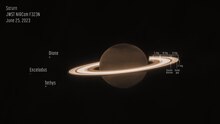
One Reply to “Rings of Saturn”
Comments are closed.




V 1.1. Added all the new and changed Icons to be 2.70 compatible, and darkened the backgrounds a little.